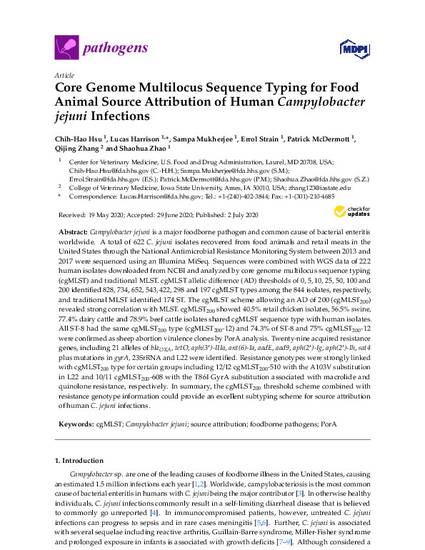
Campylobacter jejuni is a major foodborne pathogen and common cause of bacterial enteritis worldwide. A total of 622 C. jejuni isolates recovered from food animals and retail meats in the United States through the National Antimicrobial Resistance Monitoring System between 2013 and 2017 were sequenced using an Illumina MiSeq. Sequences were combined with WGS data of 222 human isolates downloaded from NCBI and analyzed by core genome multilocus sequence typing (cgMLST) and traditional MLST. cgMLST allelic difference (AD) thresholds of 0, 5, 10, 25, 50, 100 and 200 identified 828, 734, 652, 543, 422, 298 and 197 cgMLST types among the 844 isolates, respectively, and traditional MLST identified 174 ST. The cgMLST scheme allowing an AD of 200 (cgMLST200) revealed strong correlation with MLST. cgMLST200 showed 40.5% retail chicken isolates, 56.5% swine, 77.4% dairy cattle and 78.9% beef cattle isolates shared cgMLST sequence type with human isolates. All ST-8 had the same cgMLST200 type (cgMLST200-12) and 74.3% of ST-8 and 75% cgMLST200-12 were confirmed as sheep abortion virulence clones by PorA analysis. Twenty-nine acquired resistance genes, including 21 alleles of blaOXA, tetO, aph(3′)-IIIa, ant(6)-Ia, aadE, aad9, aph(2′)-Ig, aph(2′)-Ih, sat4 plus mutations in gyrA, 23SrRNA and L22 were identified. Resistance genotypes were strongly linked with cgMLST200 type for certain groups including 12/12 cgMLST200-510 with the A103V substitution in L22 and 10/11 cgMLST200-608 with the T86I GyrA substitution associated with macrolide and quinolone resistance, respectively. In summary, the cgMLST200 threshold scheme combined with resistance genotype information could provide an excellent subtyping scheme for source attribution of human C. jejuni infections.
Available at: http://works.bepress.com/qijing-zhang/95/

This article is published as Hsu, Chih-Hao, Lucas Harrison, Sampa Mukherjee, Errol Strain, Patrick McDermott, Qijing Zhang, and Shaohua Zhao. "Core Genome Multilocus Sequence Typing for Food Animal Source Attribution of Human Campylobacter jejuni Infections." Pathogens 9, no. 7 (2020): 532. DOI: 10.3390/pathogens9070532.